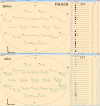Corticosteroid therapy in regressive autism: a retrospective study of effects on the Frequency Modulated Auditory Evoked Response (FMAER), language, and behavior
- PMID: 24885033
- PMCID: PMC4022403
- DOI: 10.1186/1471-2377-14-70
Corticosteroid therapy in regressive autism: a retrospective study of effects on the Frequency Modulated Auditory Evoked Response (FMAER), language, and behavior
Abstract
Background: Up to a third of children with Autism Spectrum Disorder (ASD) manifest regressive autism (R-ASD).They show normal early development followed by loss of language and social skills. Absent evidence-based therapies, anecdotal evidence suggests improvement following use of corticosteroids. This study examined the effects of corticosteroids for R-ASD children upon the 4 Hz frequency modulated evoked response (FMAER) arising from language cortex of the superior temporal gyrus (STG) and upon EEG background activity, language, and behavior. An untreated clinical convenience sample of ASD children served as control sample.
Methods: Twenty steroid-treated R-ASD (STAR) and 24 not-treated ASD patients (NSA), aged 3 - 5 years, were retrospectively identified from a large database. All study participants had two sequential FMAER and EEG studies;Landau-Kleffner syndrome diagnosis was excluded. All subjects' records contained clinical receptive and expressive language ratings based upon a priori developed metrics. The STAR group additionally was scored behaviorally regarding symptom severity as based on the Diagnostic and Statistical Manual IV (DSM-IV) ASD criteria list. EEGs were visually scored for abnormalities. FMAER responses were assessed quantitatively by spectral analysis. Treated and untreated group means and standard deviations for the FMAER, EEG, language, and behavior, were compared by paired t-test and Fisher's exact tests.
Results: The STAR group showed a significant increase in the 4 Hz FMAER spectral response and a significant reduction in response distortion compared to the NSA group. Star group subjects' language ratings were significantly improved and more STAR than NSA group subjects showed significant language improvement. Most STAR group children showed significant behavioral improvement after treatment. STAR group language and behavior improvement was retained one year after treatment. Groups did not differ in terms of minor EEG abnormalities. Steroid treatment produced no lasting morbidity.
Conclusions: Steroid treatment was associated with a significantly increased FMAER response magnitude, reduction of FMAER response distortion, and improvement in language and behavior scores. This was not observed in the non-treated group. These pilot findings warrant a prospective randomized validation trial of steroid treatment for R-ASD utilizing FMAER, EEG, and standardized ASD, language and behavior measures, and a longer follow-up period.Please see related article http://www.biomedcentral.com/1741-7015/12/79.
Figures

Comment in
-
Corticosteroid therapy in regressive autism: Preliminary findings from a retrospective study.BMC Med. 2014 May 15;12:79. doi: 10.1186/1741-7015-12-79. BMC Med. 2014. PMID: 24884537 Free PMC article.
Similar articles
-
Corticosteroid therapy in regressive autism: Preliminary findings from a retrospective study.BMC Med. 2014 May 15;12:79. doi: 10.1186/1741-7015-12-79. BMC Med. 2014. PMID: 24884537 Free PMC article.
-
The frequency modulated auditory evoked response (FMAER), a technical advance for study of childhood language disorders: cortical source localization and selected case studies.BMC Neurol. 2013 Jan 25;13:12. doi: 10.1186/1471-2377-13-12. BMC Neurol. 2013. PMID: 23351174 Free PMC article.
-
Translating Adult Electrophysiology Findings to Younger Patient Populations: Difficulty Measuring 40-Hz Auditory Steady-State Responses in Typically Developing Children and Children with Autism Spectrum Disorder.Dev Neurosci. 2016;38(1):1-14. doi: 10.1159/000441943. Epub 2016 Jan 6. Dev Neurosci. 2016. PMID: 26730806 Free PMC article.
-
Abnormalities in both stimulus-induced and baseline MEG alpha oscillations in the auditory cortex of children with Autism Spectrum Disorder.Brain Struct Funct. 2024 Jun;229(5):1225-1242. doi: 10.1007/s00429-024-02802-7. Epub 2024 Apr 29. Brain Struct Funct. 2024. PMID: 38683212
-
Electroencephalography in Autism Spectrum Disorder.J Clin Med. 2025 Mar 11;14(6):1882. doi: 10.3390/jcm14061882. J Clin Med. 2025. PMID: 40142690 Free PMC article. Review.
Cited by
-
Review of Clinical Studies Targeting Inflammatory Pathways for Individuals With Autism.Front Psychiatry. 2019 Nov 25;10:849. doi: 10.3389/fpsyt.2019.00849. eCollection 2019. Front Psychiatry. 2019. PMID: 31824351 Free PMC article. Review.
-
Pharmacotherapy for the core symptoms of autism spectrum disorder.J Zhejiang Univ Sci B. 2024 Nov 15;25(11):956-971. doi: 10.1631/jzus.B2300864. J Zhejiang Univ Sci B. 2024. PMID: 39626879 Free PMC article. Review.
-
Is Autism Inborn And Lifelong For Everyone?Neuropsychiatr Dis Treat. 2019 Oct 7;15:2885-2891. doi: 10.2147/NDT.S221901. eCollection 2019. Neuropsychiatr Dis Treat. 2019. PMID: 31632036 Free PMC article.
-
Combination of Steroid and Flavonoid for the Treatment of Regressive Autism.J Neurosci Rural Pract. 2020 Jan;11(1):216-218. doi: 10.1055/s-0040-1701367. Epub 2020 Jan 27. J Neurosci Rural Pract. 2020. PMID: 32140034 Free PMC article. No abstract available.
-
Inflammation and Neuro-Immune Dysregulations in Autism Spectrum Disorders.Pharmaceuticals (Basel). 2018 Jun 4;11(2):56. doi: 10.3390/ph11020056. Pharmaceuticals (Basel). 2018. PMID: 29867038 Free PMC article. Review.
References
-
- Baio J. Prevalence of Autism Spectrum Disorders — Autism and Developmental Disabilities Monitoring Network, 14 Sites, United States, 2008. MMWR Surveill Summ. 2012;61((SS03)):1–19. - PubMed
Publication types
MeSH terms
Substances
Grants and funding
LinkOut - more resources
Full Text Sources
Other Literature Sources
Medical

